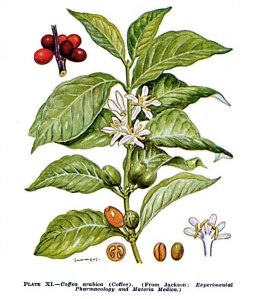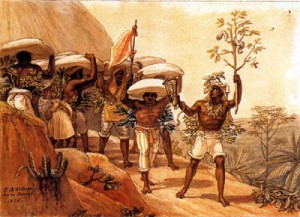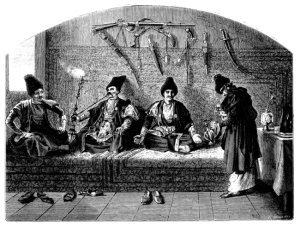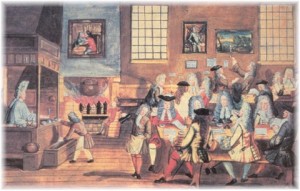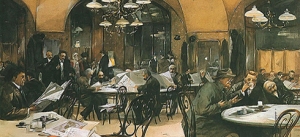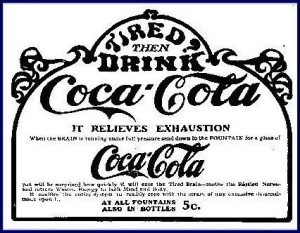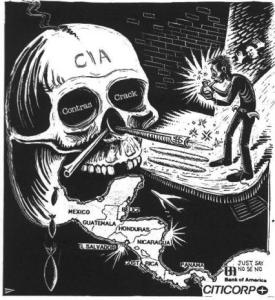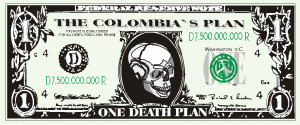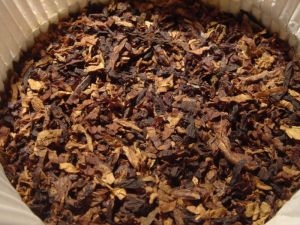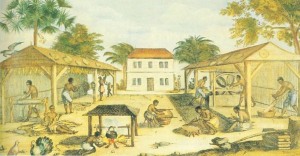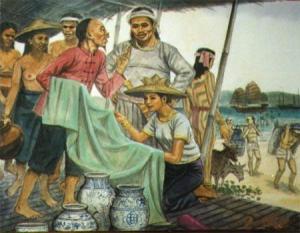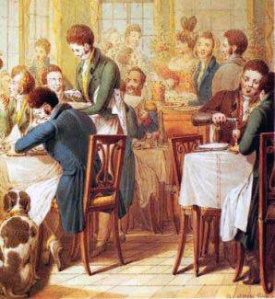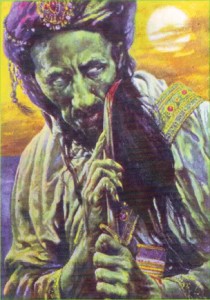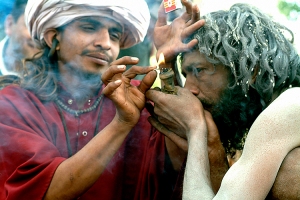Modern European civilization has cursed all of humanity. This curse now also includes all of the multiple autochthonous nations suffering inside of the European continent.
We all live as mental slaves to the petty hatreds, ego manias, sufferings and ignorance that first raped that same continent some two thousand years ago. Even worse is that we cannot turn back the historical clock: Earth’s humanity is moving on a clear and vile path to violent suicide.
Dinosaurs had their millions of years of glory, and soon the darkened farewell of time will arrive for us too. The putrid excrement and historical brutality surrounding the plant-drug of Coffea Arabica, or Coffee, proves such statements.
In Sao Paolo, Brazil, the regular people told tales about the murders that took place in late 1700s. Even with the expulsion of the Jesuits, their protected Guarani native nation, the discovery of gold in Minas Gerais, and the complete extermination of the coastal Tupamori native nation, the slave-plantation system in Portuguese colonial Brazil had recently transformed into a massive African Death Camp.
In northern Brazil, Bahia and Marañao, there weren’t any more Tupamori and Guarani native slaves to kidnap and work to death. Only pretos, or black victims, died en masse on the plantations, called Fazendas, deep in the red-hot blood pools of African flesh, mixed with dirty sea salt.
Some of the slave owners-traders-mass murderers dumped their weakened, useless slaves into the South Atlantic for shark feed. Other masters simply sardine packaged their slaves, in order to send them to the more sadistic fazendas in the south of the colony where the slave traffickers lived, called Paulistas. Sao Paolo is a now a Latin American megalopolis, but at one time, with Cartagena, Colombia, it was one of the slave trafficking centers of colonial Latin America.
Most of the slave fazendas produced sugar and manioc. But a new crop entered the evil world of African slavery in the Americas: coffee, or cafe. This plantation slave work was almost as brutal as sugar cane cutting and processing. The torturous labor required heavy hand work and bending of the body of the African in order to grab enough of the ripened red beans. The small factories later dried, heated and ground the beans down to a darkened hue resembling excrement and the African skin color. These small factories abused their African slave labor horribly. In southern colonial Brazil, the average lifespan working on a coffee slave plantation was around seven years.
There was one Portuguese white, or branco slave owner, arrayed in the pony tail, vest coat with tails, and knee breeches of late Eighteenth-century look, who used a peculiar method in maintaining control over his slaves. Some slaves escaped from the death-work infernos and became quilombos, or escaped slaves. This slave owner wanted complete labor control over his kidnapped African victims and the avoidance of any and all escapes.
He would usually purchase a sickly group of famished Africans recently off the slave ships. He then forced his slaves into a horizontal line on his plantation. None of them understood Portuguese, so he picked out the weakest of the bunch, often a young adult, skinny, almost dying African, and the owner then beat the kidnapped African to death, with the weapons of his choice, in front of the entire group. The shock of the murder would get the job done. This human monster never did any prison time for his mass murders. Most of this slave-owning class-criminals lived as respected white men within the black coffee-sugar white infernos of colonial Brazil.
Coffee production helped stabilize and augment the African slave plantation system in the Americas. Colonial Brazil was not the only place where such killing centers existed. During the late 1700s, the French also increased their African slave operations in Saint Domingue, (Haiti), Martinique and Guadeloupe, through the black gold of coffee. Sugar was the main export crop, but Coffee followed right behind it.
The British began coffee production in its colony of Ceylon, but soon switched to tea leaves. The Dutch also began coffee production on its colonial Malay islands of Java and Sumatra, (Indonesia). Unto this very day, Coffea Arabica maintains its associations with the most brutal conditions of capitalism: slavery, child labor, putting workers in debt to their owners, and murdering the poor through overwork. The irony regarding the massive kidnapping rings, ruthless slavery, and cruel murder system within colonial coffee, was that the coffee bean became another hostage from Africa.
Euro-Colonial thieves, kidnappers, mass murderers, and slave masters, with other elite arch criminals, have transformed the Coffee bean into the worldwide soft drug commodity of today.
The African elixir of coffee is the ultimate soft drug-stimulant with its high possession of caffeine. It doesn’t have any of the depressant effects of alcohol, nor does it contain the quick ego spikes of coca leaf. Because of its stimulant magic, coffee is now the prerequisite for billions of humans during their dreaded morning rituals, pathetic work schemes, and after meal snacks.
It has become the shared social sacrament for modern life’s rituals: friendly conversations, dating games, and hobby group meet ups. Coffee has even transcended into the drug pre-requisite for modern life, and the synthetic struggle against drowsiness in our modern times. The sleep of modern humanity has never been the same.
Coffee had its first cultivation in the highlands of Ethiopia, in the region of Kaffa. Legend has it that an Ethiopian farmer named Kaldi was the first human to successfully grow it. After the Islamic world culture took possession of most of Arabia, the Levant, Mesopotamia, North Africa and Iberia, Islamic merchants discovered the wondrous concoctions of this bean. They crushed the beans into a fine powder, and through boiling the grounds with water, created a liquid paradise.
The Koran, the Muslim holy scriptures, condemned the abuse of alcohol intoxicants, while this drug did not make people stupid, aggressive, nor act foolish. In fact, Coffee transformed its users into a more alert, intelligent and chatty group. Islam had found the sacred wine of spiritual elixir. Its center of trade was in Mocha, Yemen, where a great urban civilization existed, featuring the world’s first tall buildings and where almost every conceivable spice from Asia to Africa had its display vats in the merchants’ stalls.
Sufi mystics began to use coffee wine both during their orations of the sacred Koran and their worship ceremonies of dance, song, psalms and prayers. Coffee even joined with the magical herb of Hashish residues to become the drugs of choice across Islamic civilization, from the far east representing the Great Muslim Emirates of India to the far west, Al-Andalus in Modern Spain. Like farmers’ milk and beehive honey, Coffea Arabica mixed in good company with the toke of Cannabis Sativa.
When the Ottoman Turks conquered Constantinople in 1453, they became the Third Rome in competition with the Russian Czarist Empire and the Papal States in Italy. Under this great Turkish Islamic Civilization, the first ‘cafes’ opened. The cafe became an integral social space in a Muslim man’s life. After midday prayers at the mosque, Muslim men could gather at the cafe and enjoy fine, elevating conversation over some delicious Turkish coffee.
As Christendom, representing the Europeans, began to fight wars against Muslim Turkish Empire, called the Sultanate of the Sublime Port, they also discovered the wonders of the Coffee Drug. First, the Venetian Sea-Slave Empire, or La Serenissima, began to trade in the roasted black beans. Coffee became synonymous with wealth and upper class parasites, while having a ‘bitter, but good taste.’ The rest of Europe had to grab a piece of the blackened pie.
Europeans, always experts in the art of stealing and appropriating non-European cultures, and then proclaiming themselves the originators, tried to monopolize the cultivation and trade of coffee. We return to the evil system of African slavery in Brazil.
During the middle of the seventeenth-century, the 1600s, the first coffeehouses and cafes opened across Europe. Gentlemen across Europe visited the cafes, imbibed the brews, and discussed art, street philosophy – and politics. Women and royal authorities also became nervous about these contentious male spaces.
In Paris, the main cafe was right next to the Comédie Français. Did the royal emperor of France, Louis XIV, want French gentilehommes discussing politics and religion after seeing a work of Molière? The royal authorities in London closed down many of the coffeehouses, due to ‘issues of State.’
By the eighteenth-century, the 1700s, the British slavers and colonial murderers began to cultivate the beans on their sadistic slave plantations in Jamaica, as both the French did in Haiti and the Portuguese had earlier done in Brazil. The Spanish followed with their own coffee plantations stretching from the expropriated Mayan lands of Guatemala and Honduras, to the fields around Veracruz, Mexico and Cartagena, Colombia. They later planted coffee around the massive Sugar-African slave estates of Cuba. The Dutch joined the Coffee, Sugar, Slave triumvirate, which created extensive plantations in their American-Caribbean colonies of Bresil-Aruba-Curaçao-Suriname.
With Industrial Capitalism in full motion around Europe and North America, during the middle of the nineteenth-century, the 1800s, Coffee took the lead as the beverage of choice for factory laborers. Coffee also goes well with another herb drug, Nicotiana Tabacum, or Tobacco. The modern work ritual-habit had birthed. Better to have coffee-tobacco addicts than drunks.
By this historical epoch, the European corporate entities had overtaken the Arabs, Africans, Asians and Muslims as the premier sellers of the international brew. Coffee was a lot cheaper to consume. The owners loved it too: more work with cheaper wages and labor costs.
And so it continues to this very day, with special thanks to the coffee corporate chain of Starbucks, the price of Coffee has increased across the globe. Still, coffee consumption remains cheaper than spending money in local alcoholic dens with rude bartenders, (most of whom really aren’t trained bartenders anyway), and crazed, degraded customers who can’t handle their drinking. Coffee doesn’t turn you into a pathetic fool, although it does encourage excessive bowel movements, and it can make one ‘a little edgy.’
Unlike the European varieties, local cafes in the States, meaning coffee-house cafes, now often attract a motley clientage. The list includes bored-rebellious teenagers, pathetic hipsters, lonely, older male spinsters, unsuccessful folk guitarists, social cross sections of unemployable men, ex-drunks and junkies on their 12 step breaks, pseudo-Anarchist ranters, and other, assorted bizarre characters. As an unemployed PhD weirdo in the humanities, I unfortunately include myself in this group.
The article of this essay drinks at least three to four cups of coffee per day. I know some Anarchists that drink even more cups of coffee as a daily custom.
Coffee is a soft, wonder drug. It is the perfect stimulant for both the draining life of the wage slave and for encouraging the dying art of conversation. Coffee tastes great after a delicious home-made meal, while it often encourages a quick run to the toilet – and if one feels a need for an emergency work break.
European civilization has destroyed another sacred plant and bean, all in its desire to control the commodity under global monopoly capitalism. European colonials had first stolen and murdered millions of humans, animals and plants across the Western Hemisphere, or the Americas, as they named it.
They soon expropriated Tobacco, Chocolate and Coca Leaf. They have done the same across Asia, appropriating Tea, Sugar and Cannabis, and now comes Africa, the plundering of Coffee, Ivory, Gold, Diamonds, Scarce Metals, and most ominously – millions of kidnapped and murdered Africans, bought, sold, worked, murdered en masse.
European colonialism has thus murdered the African in order to process their own native African plant, while millions of native Africans have died horrendously across the foreign soils of the Americas. This peculiar genocide has yet to receive its Holocaust Museum.
Only the sickman of human civilization could have invented such nefarious history.
